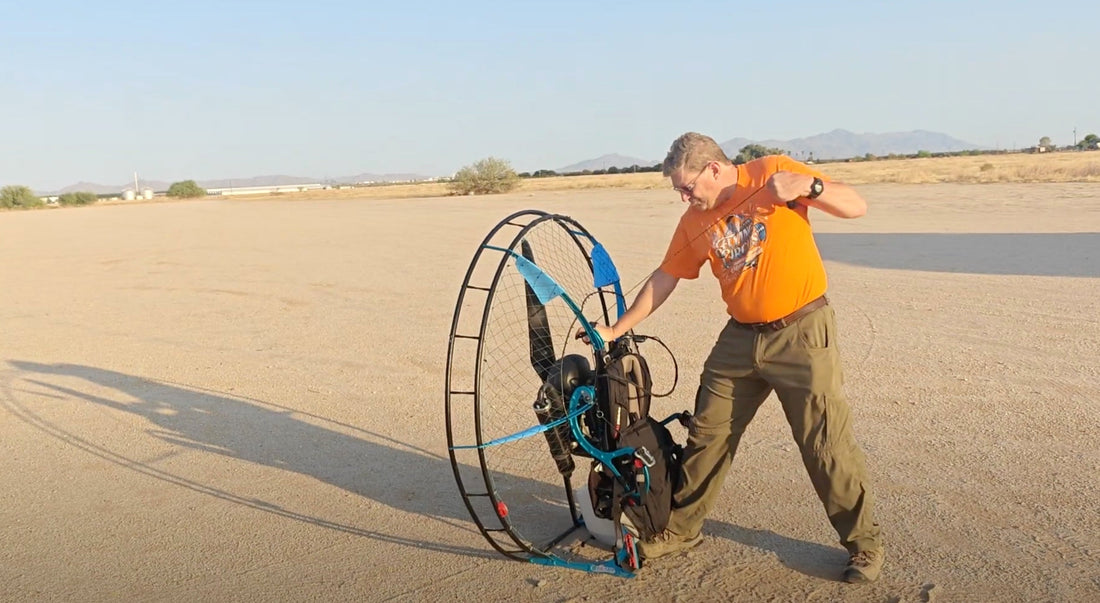Ground Start Your Moment
13 Jul 2025
0 Kommentare
In our quest to design the Moment Paramotor, we dedicated over a decade of research and development to carefully study and test what makes a paramotor unit safe or unsafe. Ground starts were of particular concern to us since they had developed a well deserved reputation of being extremely risky, causing many serious injuries to pilots.
Firstly, we pioneered an important part of this ground starting problem by identifying 3 important ground start safety design elements that enable the safety for ground starts on a paramotor frame:
- A wide, deep, stable base on the ground. This helps to keep the paramotor unit grounded and from rotating or falling over during the starting sequence. Most paramotors have narrow and unstable bases.
- A tube or bar on the frame directly below the harness just above the ground level. This offers the pilot a method to stabilize and brace the paramotor to the ground with their foot. Most paramotor units do not have this feature.
- An unobtrusive, minimal, hand hold at the top of the unit. This helps the pilot to further stabilize the paramotor unit and keep the throttle functions free and open. Again, many units do not have this feature.
Unfortunately, less than 10% of current paramotor designs incorporate these 3 ground start safety design elements. As such, most current paramotor designs (upwards of 90%) are simply not safe and potentially dangerous for ground starting since they fail to incorporate these 3 ground start safety design elements.
We created a paramotor that seamlessly implements these 3 ground start safety design elements in the Moment Paramotor. The result is possibly the safest paramotor ever made for ground starts. For example, the Moment base is super wide and deep, 19" wide by 19" deep (49cm by 49cm), by far the largest and most stable base on any paramotor available. Additionally, the horizontal tube directly below the harness offers the pilot an easy placement to step on and ground the unit. Lastly, the upper hand grip is minimalistic, unobtrusive, sturdy, and offers a perfect place for your throttle hand to help stabilize and brace the motor unit and freely operate the throttle controls.
If a pilot chooses to ground start their paramotor, it is critical to respect the dangers of a fast rotating propeller and follow proven protocols to keep the pilot safe. These protocols include:
- Only ground start a paramotor that incorporates all 3 ground start safety design elements.
- Carefully preflight the motor and frame.
- Test and visually inspect that the throttle functions operate normally.
- Assume the motor can go to full throttle anytime during the startup.
- Hold the throttle in hand, with full access to the kill button at all times during the starting sequence.
- Place the throttle lever so it doesn't accidentally get pushed or pinned if the motor throttles up.
- Brace and properly ground the motor unit with your foot, knee, hands, and upper body.
- Keep your hands, other body parts, and other people away from the netting and cage hoop.
- If the motor is clutched, using a strong strap to restrain the propeller from spinning adds significant safety.
- Before starting the motor, always announce the start of the motor with a loud "clear prop!"
- Once the motor is started, do not spin up the prop quickly. During a ground start, the prop tips come within inches of the ground. Debris, sand, or rocks will get sucked into the fast moving prop and quickly damage the prop and potentially injure bystanders.
- Never leave a running motor running unattended.
In summary, using a properly designed paramotor unit that incorporated the 3 ground start safety elements (such as a Moment Paramotor) AND with proper technique and a strong respect for the dangers involved, ground starts can be conducted safely and with minimal risk of injury to the pilot.


